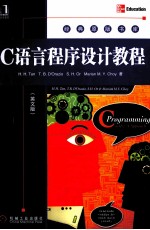

C语言程序设计教程 英文PDF电子书下载
- 电子书积分:16 积分如何计算积分?
- 作 者:(美)坦等著
- 出 版 社:北京:机械工业出版社
- 出版年份:2013
- ISBN:9787111404323
- 页数:542 页
Chapter 1 Programming Fundamentals 1
Lesson 1.1 Programming Languages 1
1.1.1 Assembly Language 1
1.1.2 High Level Languages 2
Lesson 1.2 Software Engineering 4
1.2.1 Top-down Modular Design 5
Lesson 1.3 The C Language,ANSI C and C Compilers 7
1.3.1 C and ANSI C 7
1.3.2 Program Development 8
Lesson 1.4 Using Bits to Represent Characters and Symbols,Integers,Real Numbers,Addresses and Instructions 11
1.4.1 Characters and Symbols 11
1.4.2 Integers 12
1.4.3 Real Numbers 14
1.4.4 Hexadecimal and Octal Notations 15
Lesson 1.5 About This Textbook and How to Get The Most Out of It 16
1.5.1 The Lesson 17
1.5.2 The Application Programs 17
Lesson 1.6 Basic Structure 19
Lesson 1.7 Formatting Output 27
Lesson 1.8 More Escape Sequences 30
Lesson 1.9 Basic Debugging 34
Chapter Review 37
Chapter 2 Variables,Arithmetic Expressions and Input/Output 38
Lesson 2.1 Variables:Naming,Declaring,Assigning and Printing Values 38
Lesson 2.2 Arithmetic Operators and Expressions 47
Lesson 2.3 Reading Data from the Keyboard 52
Lesson 2.4 Constant Macros and More About Printing Variable Values 57
Lesson 2.5 Mixed Type Arithmetic,Compound Assignment,Operator Precedence and Type Casting 69
Chapter Review 83
Chapter 3 The Basics of C-Math Functions and Character File Input/Output 84
Lesson 3.1 Math Library Functions 84
Lesson 3.2 Single Character Data 90
Lesson 3.3 Reading Data From a File 105
Lesson 3.4 Writing Output To a File 112
Application Program 3.1 Area Calculation-Compound Operators and Program Development 115
Application Exercises 119
Chapter Review 123
Chapter 4 Beginning Decision Making and Looping 124
Lesson 4.1 If Control Structure and Relational Expressions 125
Lesson 4.2 Simple If-Else Control Structures 130
Lesson 4.3 Nested If-Else Control Structures 135
Lesson 4.4 Logical Expressions 138
Lesson 4.5 Precedence of Logical Operators 142
Lesson 4.6 Switch and If-Else-If Control Structures 147
Lesson 4.7 While Loop(1) 156
Lesson 4.8 While Loop(2) 160
Lesson 4.9 Do-While Loops 162
Lesson 4.10 Simple For Loop 165
Lesson 4.11 Nested For Loops 170
Application Program 4.1 Girder Intersection-If-Else Control Structure 176
Application Program 4.2 Area Calculation-For Loop 179
Application Program 4.3 Temperature Unit Conversions-For Loop 181
Application Program 4.4 Temperature Unit Conversions-Loop and If-Else Control Structure 183
Application Program 4.5 Simulation 185
Application Program 4.6 Engineering Economics-Nested For Loops 187
Application Program 4.7 Solving a Quadratic Equation-If-Else Control Structure(Numerical Method Example) 191
Application Exercises 194
Chapter Review 198
Chapter 5 Functions 199
Lesson 5.1 Functions That Do Not Return a Value 204
Lesson 5.2 Functions That Return Just One Value 216
Lesson 5.3 Scope and Mechanics of Passing Values to Functions 223
Lesson 5.4 Functions That"Return"More Than One Value 230
Lesson 5.5 Mechanics of"Returning"More Than One Value from a Function-Addresses and Pointer Variables 235
Application Program 5.1 Using Functions With Complex Loops and Working with Grids(a Logic Example) 244
Application Program 5.2 Modular Program Design-Area of Parallelogram,Volume of Parallelepiped(Numerical Method Example) 252
Application Exercises 258
Chapter Review 268
Chapter 6 Numeric Arrays 269
Lesson 6.1 Introduction to 1-D Arrays and Printing Array Elements 270
Lesson 6.2 Array Initialisation 277
Lesson 6.3 Basic Array Input/Output 282
Lesson 6.4 Multidimensional Arrays 288
Lesson 6.5 Functions and Arrays 298
Lesson 6.6 Bubble Sort,Exchange Maximum Sort and Exchange Minimum Sort 305
Application Program 6.1 Deriving a 16-bit Adder from Sixteen 1-Bit Adders 313
Application Program 6.2 Mean and Median of Measured Wave Heights(Numerical Method Example) 317
Application Program 6.3 Matrix-Vector Multiplication(Numerical Method Example) 323
Application Program 6.4 Searching and File Compression 327
Application Exercises 332
Chapter Review 339
Chapter 7 Strings and Pointers 340
Lesson 7.1 Declaring,Initialising and Printing Strings and Understanding Memory Arrangement 343
Lesson 7.2 Determining Information About Strings and Characters and Using Printf 353
Lesson 7.3 2-D Character Arrays 361
Lesson 7.4 Reading Strings from The Keyboard and Files 367
Lesson 7.5 Pointer Variables Versus Array Variables 377
Lesson 7.6 Initialising Within a Declaration 386
Lesson 7.7 Passing Strings to User-Defined Functions 393
Lesson 7.8 Standard Character String Functions 400
Lesson 7.9 Pointer Notation Versus Array Notation 416
Lesson 7.10 Dynamic Memory Allocation 427
Program Development Methodology 436
Application Program 7.1 Pipe Fluid Velocity,Checking Input Data and Modular Design 437
Application Program 7.2 Earthquake Anecdotal Report Analysis,String Operations and Dynamic Storage Allocation 449
Application Exercises 464
Chapter Review 469
Chapter 8 Structures and Large Program Design 470
Part Ⅰ:Data Structures 470
Structures in C 471
Lesson 8.1 Structures 472
Lesson 8.2 Structure Members 480
Lesson 8.3 Pointers to Structures 484
Lesson 8.4 Structures and Functions 487
Lesson 8.5 Arrays of Structures 489
Part Ⅱ:Advanced Programming Techniques 492
Lesson 8.6 Functions With One Recursive Call 492
Lesson 8.7 Creating Header Files 500
Lesson 8.8 Use of Multiple Source Code Files and Storage Classes 503
Lesson 8.9 Bitwise Manipulations 507
Application Program 8.1 Sorting-Quicksort Algorithm 521
Chapter Review 534
Chapter 9 An Introduction to C+++(Online Chapter) 535
Appendix A 535
Appendix B 536
Index 537
- 《高级英语阅读与听说教程》刘秀梅编著 2019
- 《看图自学吉他弹唱教程》陈飞编著 2019
- 《激光加工实训技能指导理实一体化教程 下》王秀军,徐永红主编;刘波,刘克生副主编 2017
- 《AutoCAD 2019 循序渐进教程》雷焕平,吴昌松,陈兴奎主编 2019
- 《少儿电子琴入门教程 双色图解版》灌木文化 2019
- 《指向核心素养 北京十一学校名师教学设计 英语 七年级 上 配人教版》周志英总主编 2019
- 《Photoshop CC 2018基础教程》温培利,付华编著 2019
- 《剑桥国际英语写作教程 段落写作》(美)吉尔·辛格尔顿(Jill Shingleton)编著 2019
- 《英语自学进阶教程全6册 3》爱尔兰迪尔德丽出版社著 2019
- 《设计十六日 国内外美术院校报考攻略》沈海泯著 2018
- 《断陷湖盆比较沉积学与油气储层》赵永胜等著 1996
- 《SQL与关系数据库理论》(美)戴特(C.J.Date) 2019
- 《魔法销售台词》(美)埃尔默·惠勒著 2019
- 《看漫画学钢琴 技巧 3》高宁译;(日)川崎美雪 2019
- 《优势谈判 15周年经典版》(美)罗杰·道森 2018
- 《社会学与人类生活 社会问题解析 第11版》(美)James M. Henslin(詹姆斯·M. 汉斯林) 2019
- 《海明威书信集:1917-1961 下》(美)海明威(Ernest Hemingway)著;潘小松译 2019
- 《迁徙 默温自选诗集 上》(美)W.S.默温著;伽禾译 2020
- 《上帝的孤独者 下 托马斯·沃尔夫短篇小说集》(美)托马斯·沃尔夫著;刘积源译 2017
- 《巴黎永远没个完》(美)海明威著 2017
- 《指向核心素养 北京十一学校名师教学设计 英语 七年级 上 配人教版》周志英总主编 2019
- 《北京生态环境保护》《北京环境保护丛书》编委会编著 2018
- 《高等教育双机械基础课程系列教材 高等学校教材 机械设计课程设计手册 第5版》吴宗泽,罗圣国,高志,李威 2018
- 《指向核心素养 北京十一学校名师教学设计 英语 九年级 上 配人教版》周志英总主编 2019
- 《高等院校旅游专业系列教材 旅游企业岗位培训系列教材 新编北京导游英语》杨昆,鄢莉,谭明华 2019
- 《中国十大出版家》王震,贺越明著 1991
- 《近代民营出版机构的英语函授教育 以“商务、中华、开明”函授学校为个案 1915年-1946年版》丁伟 2017
- 《新工业时代 世界级工业家张毓强和他的“新石头记”》秦朔 2019
- 《智能制造高技能人才培养规划丛书 ABB工业机器人虚拟仿真教程》(中国)工控帮教研组 2019
- 《AutoCAD机械设计实例精解 2019中文版》北京兆迪科技有限公司编著 2019
